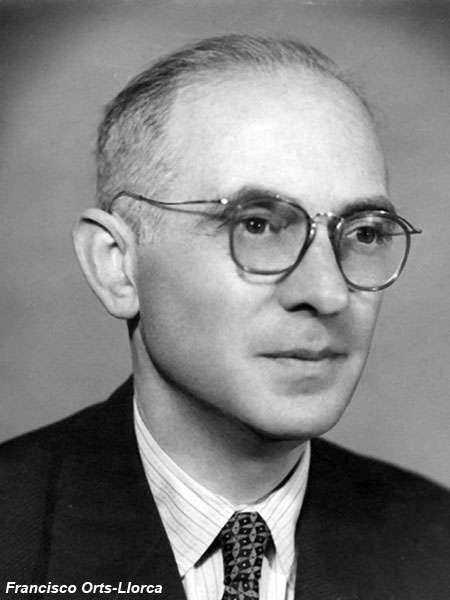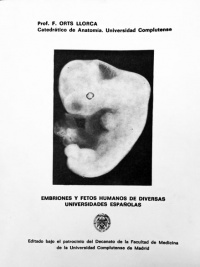File:Francisco Orts Llorca.jpg
Francisco_Orts_Llorca.jpg (450 × 600 pixels, file size: 41 KB, MIME type: image/jpeg)
Francisco Orts-Llorca (1905-1993)
Francisco Ort-Llorca (1905-1993)[1] "was one of the most outstanding Spanish embryologists of the XX century. He was disciple of Henri Rouvire in Paris (France), Alfred Fischel in Vienna (Austria), Walther Vogt in Munich (Germany) and Pedro Ara in Madrid (Spain). From 1935, he was professor of Human Anatomy at the Faculty of Medicine of Cadiz, belonged then to the University of Seville (accidentally, in the University of Valencia, during the Spanish Civil War from 1936-1939) and, later on, at the Faculty of Medicine of Madrid (Complutense University) from 1954 to 1975."
- Links: Madrid Collection
Innervation of the sinu-atrial node and neighbouring regions in two human embryos.[2]
In human embryos of 20 to 23 mm (36 to 40 days) it is possible to identify on the right side a nerve that we may call the sinusal, which originates by several roots from the nervus vagus dexter (Figs. 1A, B, D), descending through the right ventrolateral face of the primary trachea and right bronchus (Fig. 2, arrows). Beaded in appearance, it gives a fine anastomotic branch which, passing in front of the arteria pulmonalis dextra, passes to the left side (Figs. 2B, C, D; AN). At this level it gives the large branch for the nodus sinoatrialis which, penetrating through the wall of the superior vena cava, provides a rich innervation for the nodus sinoatrialis which is already in an advanced stage of differentiation (Fig. 3, 2; Cy, D, AN). Afterwards it gives fine branches which, following the atrial fold, are distributed throughout the posterior face of the atrium dextrum (Fig. 3). It increases in diameter and, passing through the angle formed by the right pulmonary veins with the atrium dextrum, reaches the intrapericardial portion of the inferior vena cava in the vicinity of its outlet from the atrium (Fig. 3, arrows). The whole innervation is parasympathetic at the stages studied.
References
- ↑ Aréchaga J, Jiménez-Collado J & Ruano-Gil D. (2009). A glance at Spanish embryology and teratology during the XX century through the academic life of Francisco Orts-Llorca (1905-1993). Int. J. Dev. Biol. , 53, 1165-77. PMID: 19924623 DOI.
- ↑ Orts Llorca F, Domenech Mateu JM & Puerta Fonolla J. (1979). Innervation of the sinu-atrial node and neighbouring regions in two human embryos. J. Anat. , 128, 365-75. PMID: 438095
Cite this page: Hill, M.A. (2024, June 20) Embryology Francisco Orts Llorca.jpg. Retrieved from https://embryology.med.unsw.edu.au/embryology/index.php/File:Francisco_Orts_Llorca.jpg
- © Dr Mark Hill 2024, UNSW Embryology ISBN: 978 0 7334 2609 4 - UNSW CRICOS Provider Code No. 00098G
File history
Yi efo/eka'e gwa ebo wo le nyangagi wuncin ye kamina wunga tinya nan
| Gwalagizhi | Nyangagi | Dimensions | User | Comment | |
|---|---|---|---|---|---|
| current | 10:59, 3 December 2014 |  | 450 × 600 (41 KB) | Z8600021 (talk | contribs) | ==Francisco Ort-Llorca (1905-1993)== :Links: Madrid Collection Category:People |
You cannot overwrite this file.
File usage
The following 8 pages use this file:

